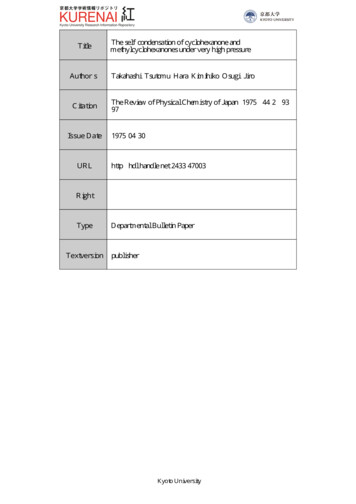
Transcription
TitleThe self-condensation of cyclohexanone andmethylcyclohexanones under very high pressureAuthor(s)Takahashi, Tsutomu; Hara, Kimihiko; Osugi, JiroCitationIssue DateURLThe Review of Physical Chemistry of Japan (1975), 44(2): tTypeTextversionDepartmental Bulletin PaperpublisherKyoto University
TheReviewof PhysicalChemistryof JapanVol. 44 No.Tf1E REVrEw OF PIIY;[CAI. CtlEatt ST[t\ nF JAPA 1, Vnt. 44, VO. 2, 1914THE SELF-CONDENSATIONANDOF CYCLOHEXANONEMETHYLCYCLOHEXANONESUNDERVERY HIGHBY Tst:TGaiL TAli.il{A;lit,PRESSUREI11AfIIIIR HARA ASa J1R0 O;L-GIThe self condensations ui q dohexanone and its methyl wbsti[uted derivatives wereinvestigated under pressures of 20--i0khar and temperatures ai 160300 C n ithoutsoh ent and/or catalyst. It x as Eound that 2-cyclohexenylq clohexanone,2-cyclohex} Iidenecydohexanpne,2, fi-dic} dohexunylc} dohexanone and dodecahydrotriphenylenewere produced from the self-condensation of cyclohexanone. Dodccahgdrotriphenylenebecomes the main product at the higher pressure and the higher temperature. 2, 2'-11ethyt{2-methylcyctobezenyl)-q clohexanonenas obtained from [he selitondensation of2-methyle) clahexanone. The reactivity of 2,fi-dimethplq dohesanonewas also examined and no product w-asobtained under pressures of 20 SOkbar and below temperaturesof 250 C.This condensation is assumed to occur in the liquid phase and [o proceed through aseries of aldol condensation followed by dehydration. This scheme teas confirmed frompressure effects, but the mechanism of this condensation cannot be explained merelyby the pressure dependence of auto-protolysis. The non-reactivity for 2, 6 dimethclcyclohexanone is reasonable in light of the larger steric hindrance.InfrodutfionThe mechanism of aldol condensation has been widely studied under atmospheric pre sure.Ketones have much lower reactivity as compared with aldehydest!.The condensation reaction ofketo es, paticularly cyclohesanones, was reported to be characteristic to the reaction at high pressureor to be highly accelerated by pressure. The condensation of q dohexaaonewas caused under pres-sures up to Skbar in the absence of a catalyst and was accelerated by pressureza .In some groups o(organic reactions, the atxurate kinetical study has been carried out under pressureup to several kbar. It is interesting, however, to investigate under the higher pressure the other groupsof the reactions which occur only a[ high pressure; even if the relative details are sacrificed.From this point of view, this paper is concerned w i[h the sell-condensation of cycloheaa o e,2-methylcyclohexanone and 2, 6-dimethylcyclohexabone under pressures of 20-30 kbar and temperatures of 140- -300'C without solvent and/or catalyst. The mechanism of these reactions was discussed(Received October t9, 1974)I) H.O. House, ")indern Synthetic Reactions". Chap. 8, l1'. A. Benjamin [nc., \eu 1 ork and :lmster dam (1965)2) R. li. Sapiro and Shu-tin P(:ng, J, Chem. Sor., 1938, I 1i 13) S. D. Hamann, "Physcco-Chemical Effects of Pressure", p. 189, Butterx orths. London (I93 i)2 (1974)
The Review of Physical Chemistry of Japan Vol. 44 No. 2 (1974)94T. Takahashi,by comparisonwitheachG. Hara and ]: Osugiother.ExperimentalMaterialsCyclohexanone, 1-methylcytlohexanoneand 2.0-dime[hyltytlohexanoneof guaranteed gradewere obtained commercially. They were dehydrated by anhydrous sodium sulfate and were distilledunder reduced pressure just before use.ApparatusHydrostatic pressures up to SOkbar were generated in a compact cubic anvil apparatus , whosecalibration techniques and other experimental procedures were reported earlier in detailal. The reactantof about I3 mg was inserted into a capsule made of Te6on. Temperature x as detected by chromelalume] thermocouples inserted through the gaps between the anvils. The junction was situated incontact with aglassy-carbon heater.Analysis of productsAll the materials presumed to be produced under pressure were synthesized by other methods described in the references citeds . The reaction products were identified Ly measuring IR, NMR andMass spectrum,The physical properties used for identification are as follows:2-Cyclohexenylcyclohexanone:b. p. l 13-C/2 mmHg. IR absorption, 1710cm-', in the C 0 vibration.N DiR spectrum, r-value 4.7 of olefin proton.2-Cyclohexylidenecyclohexanone:a-13 double bond.1. 6-Dicyclohexenylcyclohexanone:IR absorption. 16S3tm-'. in the C 0b. p. li2 C/?mmHg.vibration resonanted withIR absorption, I7IOcm-'. in the C 0 cibration. NbfR spectrum, r-value 4.7 of olefin proton.Dodecahydrotriphenylene:m. p. 236 C. N 1R spectrum, c-value 7.5 and 8.5 equivalent resonance(a-proton and a-proton)r}.2. 2'-Methyl-(Lmethylcyclohexenyl}cyclohesanonewas synthesized under the pressure of 3kbar andthe temperature of 120-130 C in the presence of p-toluenesultonic acid as catalyst and separated by meansof liquid column-chromatography. Parent peak 206 in Mass spectrum. IR absorption, 1710cm r, ofthe C 0 vibration. Tbere is no olefin proton and methin proton of a-position of the C 0 group.Determination of yieldThe products were separated each other by liquid column-chromatography used silica gel us theadsorbent and chloroform as the developer. Then, each yield w asdetermined by using a calibration4) J. Osugi,K. Shimizu, K. moue and R. Vasunami. Thislotvnal, 34, t (1964); K. Hara, Thir Journal,4D,i3 (1970)i) J Plespk,Collerl. Czech.Chew.Gammon.,21, 375 (1916)6) E. Wenkert, S. K. Bhaltacharyaand E. \f. lCilson, J. Cheer.Sou, 9rppl., 1964,56177) V. N. Selkina, A.G. Ginzur[ and E.I. Fedin, Dokl. dkad. A'mrk,SSSR,158,671 (1964)
The Review of Physical Chemistry of Japan Vol. 44 No. 2 (1974)The Self-Condensationcurvemadefrom thepeakhand.of an IR absorptionintensityResultsand95and Diethylq clahexanonesof CyclohexaooneDiscussionSelf-condensation of cyclohexanoneItsvas foundthattheself-condensationof cyclohexanone[1] produces2-cycloheaenylcyclohexanone[2], 2-tyclohexylidenecyclohezanone[3]. 2, 6-dicyclohexenylcyclohexanone[4] and dodecahydrotriphenylene [5] under pressures of 20 -SOkbarand temperatures of 180300'C in the absence of acatalyst. - o- o o-- -- 1 ,FThisture;. 1condensationbelowdoes not180 C at 45 kbar,Fig. 1. At the temperaturereactiontimeperatureincreasesand pressurehexanoneat whichacetoneto be the solidis assumedwith increasingpressure.wherethe productsin the liquid00-tiI 0aEuFhowever,the totalAnd no discontinuouswere obtained.aFig. Io--- .-ISO-C at 20 kbarphase.and at the tempera-Theresult,yield of the productspointTherefore.was observedthe condensationis shon-ninin a givenin the temof cyclo-phase.02ql V[oJbelow200' and 300'C,to occuri91at the temperaturebetweenregionis consideredoccurf3i' .Reaction diagram for the condensation of cydohexanone : Condensation : Iho condensation- -: Estimated melting curveBoa"'?030JOPressure,kbar,ri0The aldol condensationof cydohexanone in the presence of a catalyst is studied well at atmospheric pressures s1,e. g. in the presence of p-toluenesulfonicacid. [2]. [4J and [iJ were reported to beobtained at 190 Cfor 1 hour with the yield of 60 wt%, 7 wt% and 1wt%, respectively.Sapiro and Shu-lin Peng-1have studied the self-condensationof cydohexanone up to the pressureof several kbar and the temperature of 100 Cin the absence of a catalyst and obtained [2] as only oneproduct with the yield of 72wt% when the equilibriumwas achieved sufficiently. On the other hand.Bengelsdorfalhas obtained only [5] from cydohexanonewith the yield of 60 u't% at 35kbacand 320 C8) I. S. Bengdsdorf, "Amer. Chem. Soc. Meeting", Sept (1916)
The Review of Physical Chemistry of Japan Vol. 44 No. 2 (1974)'1'. Takahashi,9fiP. llaraand J, Osugifor 15 minutes without Catalyst.It was one of the objects of this research that the differencein the products between the reactionat several kbar and that at several ten kbar would be examined. It was found, however,that even atthe pressure of several ten kbar [2]. [3] and [4] are also produced besides[5]. Table 1 gives the yieldof each product at various temperatures and pressures. The yield of [3] is less than I / in all theexperimental eaction conditionTemperature Time('C)(min)200of cyclohesanoneYield (wt [21( 7fs]3051Nil'r6053Nil12044Nil25030Il12 003072Nil11192503011342003021040250 No measurable1\il302]3127yieldFollowingthe changein yield with time at a given temperature and pressure, we can find that [2]is produced first of all and then [2] reactingwith a cydohexanonefurther, [4] and [5] are broughtabout.Therefore, it is concludedthat the self-condensationunder very high pressure takes place through thesimilar process to that at atmosphericpressure. After a sufficient reaction time, [3] becomesa finalmain product. This can be well explained from the pressure effects,since the molar volumeof [3] issmaller than Cha[of [2] or [4].The yield at the same condition as that in the work of Bengelsdorfa ,i. e. 35kbar and 320'C, is43wt% and somewhatsmaller than that of Bengelsdorf.This differenceprobably comesfromthe methodof the determinationof yield. In the work of Bengelsdorf8 ,the amount of the products was determinedonly by elementary analysis.Self-condensation of 2 methylcyclohexanoneFrom the self-condensationof 2-methylcyclohexanone[b], 2, 2'-methyl-(2-methylcyclohexenyl)cydohexanone[7] was detected by the measurementof IR spectrum.0M! J[ f (cle 0(2)f71Table 2 gives the yield of [7]. The self-condensationof 2-methylcyclohexanonedoes not occur in thehigher pressure region than about 30kbar at 200 C,at which 2-methylcyclohexanoneis assumed to be
The Review of Physical Chemistry of Japan Vol. 44 No. 2 (1974)The Self-CondensationTable2of CyclohexanoueandSelf condensation(kbar)('C)1020097of Z-methylcyclohexanoneReaction min)Yield(wt%)(7]Time1503ato60203018the solid phase. As in the case of cyclohexanone,this is a reaction in the liquid phase.In the reaction at atmospheric pressure, [7] couldnever be obtained even in the presenceof ptoluenesulfonicacid as catalyst. By the application of the pressure of 3kbar, however, it was obtainedat 190 Cin the presenceof p-toluenesulfonicacid. The fact that in the self-condensationof 2-me[hylcyclohexanone,without catalyst the pressure of several [en kbar, or with catalyst the pressureof 3kbaris needed seems to come from the effectof steric hindrance by methyl group.Self-condensation of 2,G-dimethylcycloheaanoneThe self-condensationof 2, 6-dimethylcyclohexaaonedid not occur under the pressure of 2050kbar and the temperature of 250'C. It seems reasonable in light of large steric hindrance by methylgroups. It indicates that even the pressure of 50kbar cannot take it away.Hamann has explained that the self-condensationof ketone; occurs through auto-protolysisfollowed by the acid or base catalyzed aldol condensationand dehydrations ,O OFI0z HIn our results, however,tainedthe productsat an early stage of the reaction.explainedmerely by the pressuresiderationthe difference of pressurel3)through the base catalyzedaldol condensationTherefore,of this condensationdependencethe mechanismof auto-protolysis,but it is necessaryeiiects on the reaction rates betweenwere not obcannot beto take into con-the acid and base catalyzedcondensation.Laboratory of Physical ChemistryDepartment ojChemislryFaculty ojScieviceKyofo UnfversilyKyofo 606, Jnpan
The reaction products were identified Ly measuring IR, NMR and Mass spectrum, The physical properties used for identification are as follows: 2-Cyclohexenylcyclohexanone: b. p. l 13-C/2 mmHg. IR absorption, 1710cm-', in the C 0 vibration. N DiR spectrum, r-value 4.7 of olefin proton.
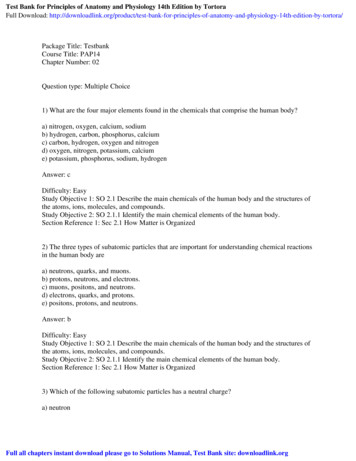


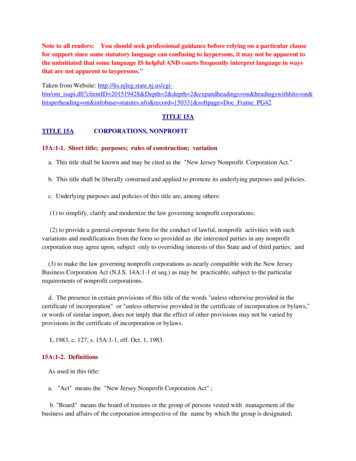



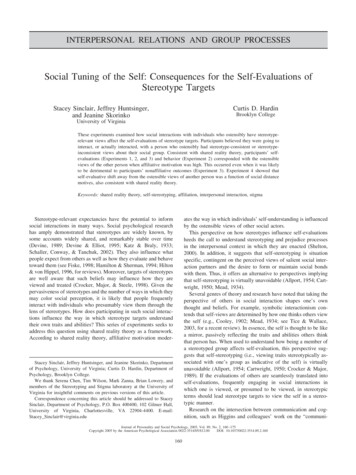
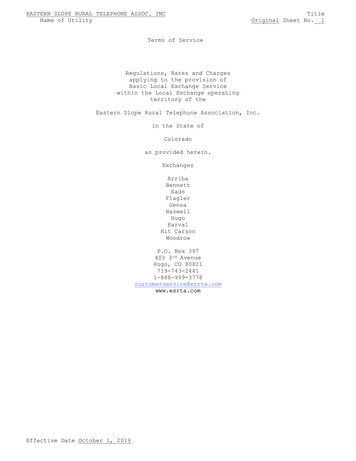
![Last or Business First [Maiden] Page Title Notes](/img/1/saukcity125thjubilee-20historical-20album-index.jpg)
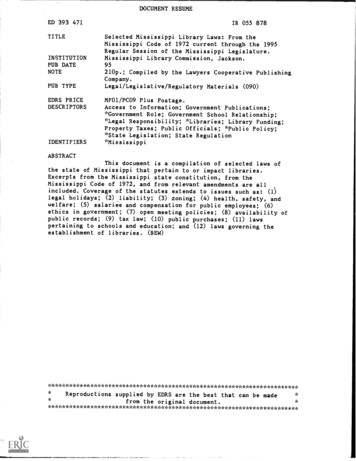
![[Code of Federal Regulations] [Title 21, Volume 8 .](/img/2/21-cfr-part-820.jpg)